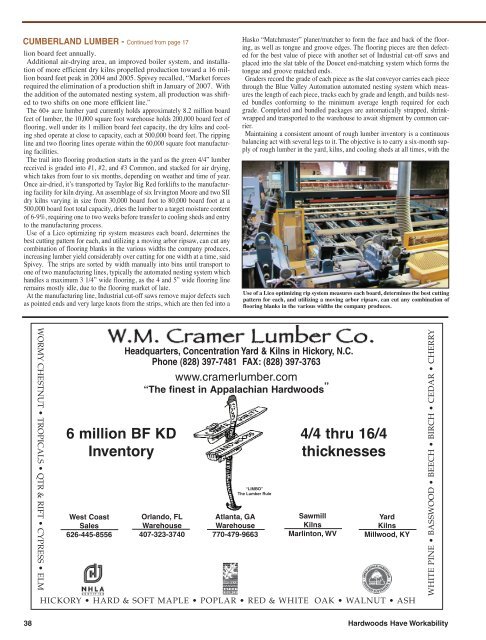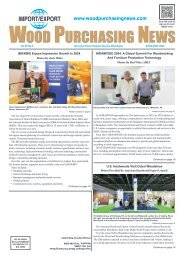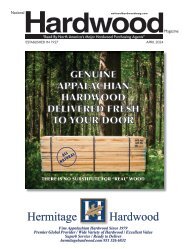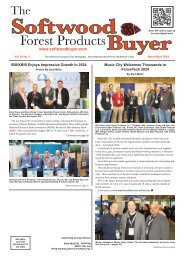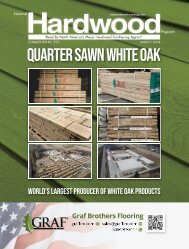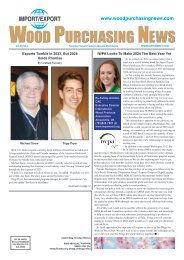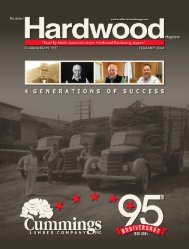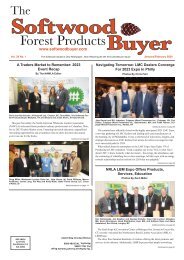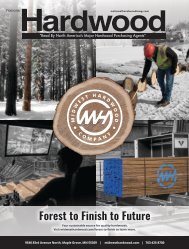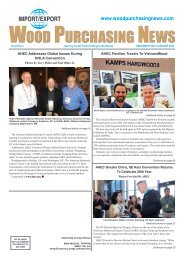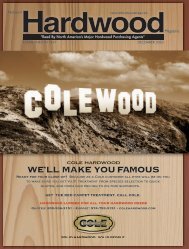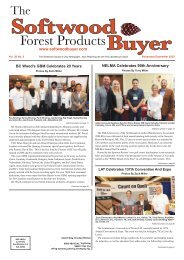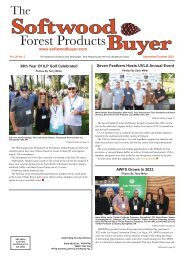National Hardwood Magazine - July 2011
Check out the National Hardwood Magazine's latest issue and stay up-to-date on all the trends, news, and industry info you need.
Check out the National Hardwood Magazine's latest issue and stay up-to-date on all the trends, news, and industry info you need.
You also want an ePaper? Increase the reach of your titles
YUMPU automatically turns print PDFs into web optimized ePapers that Google loves.
CUMBERLAND LUMBER - Continued from page 17<br />
lion board feet annually.<br />
Additional air-drying area, an improved boiler system, and installation<br />
of more efficient dry kilns propelled production toward a 16 million<br />
board feet peak in 2004 and 2005. Spivey recalled, “Market forces<br />
required the elimination of a production shift in January of 2007. With<br />
the addition of the automated nesting system, all production was shifted<br />
to two shifts on one more efficient line.”<br />
The 60+ acre lumber yard currently holds approximately 8.2 million board<br />
feet of lumber, the 10,000 square foot warehouse holds 200,000 board feet of<br />
flooring, well under its 1 million board feet capacity, the dry kilns and cooling<br />
shed operate at close to capacity, each at 500,000 board feet. The ripping<br />
line and two flooring lines operate within the 60,000 square foot manufacturing<br />
facilities.<br />
The trail into flooring production starts in the yard as the green 4/4” lumber<br />
received is graded into #1, #2, and #3 Common, and stacked for air drying,<br />
which takes from four to six months, depending on weather and time of year.<br />
Once air-dried, it’s transported by Taylor Big Red forklifts to the manufacturing<br />
facility for kiln drying. An assemblage of six Irvington Moore and two SII<br />
dry kilns varying in size from 30,000 board foot to 80,000 board foot at a<br />
500,000 board foot total capacity, dries the lumber to a target moisture content<br />
of 6-9%, requiring one to two weeks before transfer to cooling sheds and entry<br />
to the manufacturing process.<br />
Use of a Lico optimizing rip system measures each board, determines the<br />
best cutting pattern for each, and utilizing a moving arbor ripsaw, can cut any<br />
combination of flooring blanks in the various widths the company produces,<br />
increasing lumber yield considerably over cutting for one width at a time, said<br />
Spivey. The strips are sorted by width manually into bins until transport to<br />
one of two manufacturing lines, typically the automated nesting system which<br />
handles a maximum 3 1/4” wide flooring, as the 4 and 5” wide flooring line<br />
remains mostly idle, due to the flooring market of late.<br />
At the manufacturing line, Industrial cut-off saws remove major defects such<br />
as pointed ends and very large knots from the strips, which are then fed into a<br />
Hasko “Matchmaster” planer/matcher to form the face and back of the flooring,<br />
as well as tongue and groove edges. The flooring pieces are then defected<br />
for the best value of piece with another set of Industrial cut-off saws and<br />
placed into the slat table of the Doucet end-matching system which forms the<br />
tongue and groove matched ends.<br />
Graders record the grade of each piece as the slat conveyor carries each piece<br />
through the Blue Valley Automation automated nesting system which measures<br />
the length of each piece, tracks each by grade and length, and builds nested<br />
bundles conforming to the minimum average length required for each<br />
grade. Completed and bundled packages are automatically strapped, shrinkwrapped<br />
and transported to the warehouse to await shipment by common carrier.<br />
Maintaining a consistent amount of rough lumber inventory is a continuous<br />
balancing act with several legs to it. The objective is to carry a six-month supply<br />
of rough lumber in the yard, kilns, and cooling sheds at all times, with the<br />
Use of a Lico optimizing rip system measures each board, determines the best cutting<br />
pattern for each, and utilizing a moving arbor ripsaw, can cut any combination of<br />
flooring blanks in the various widths the company produces.<br />
WORMY CHESTNUT • TROPICALS • QTR & RIFT • CYPRESS • ELM<br />
6 million BF KD<br />
Inventory<br />
West Coast<br />
Sales<br />
626-445-8556<br />
Headquarters, Concentration Yard & Kilns in Hickory, N.C.<br />
Phone (828) 397-7481 FAX: (828) 397-3763<br />
www.cramerlumber.com<br />
“The finest in Appalachian <strong>Hardwood</strong>s ”<br />
Orlando, FL<br />
Warehouse<br />
407-323-3740<br />
“LIMBO”<br />
The Lumber Rule<br />
Atlanta, GA<br />
Warehouse<br />
770-479-9663<br />
4/4 thru 16/4<br />
thicknesses<br />
Sawmill<br />
Kilns<br />
Marlinton, WV<br />
Yard<br />
Kilns<br />
Millwood, KY<br />
HICKORY • HARD & SOFT MAPLE • POPLAR • RED & WHITE OAK • WALNUT • ASH<br />
WHITE PINE • BASSWOOD • BEECH • BIRCH • CEDAR • CHERRY<br />
38 <strong>Hardwood</strong>s Have Workability


